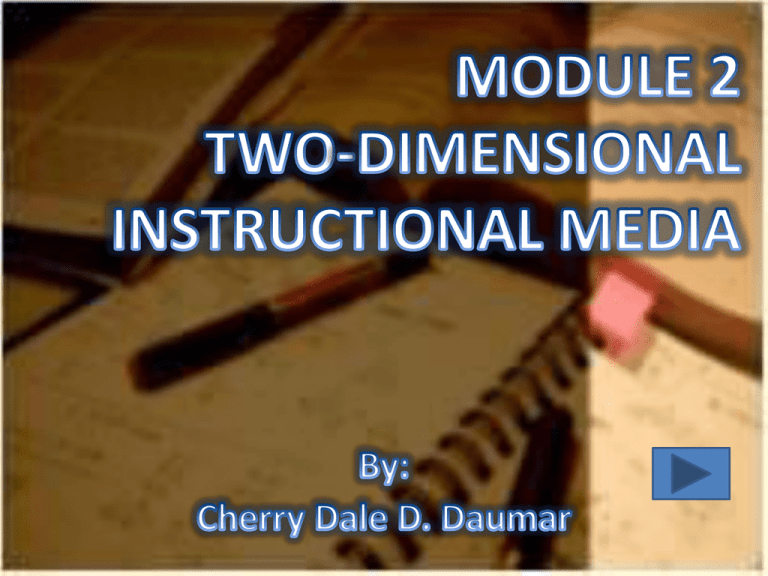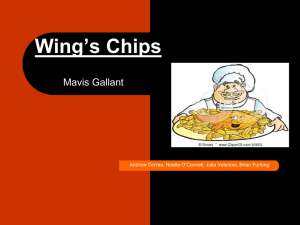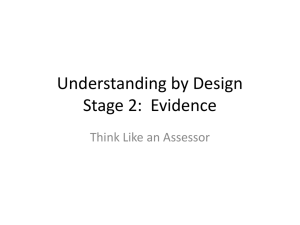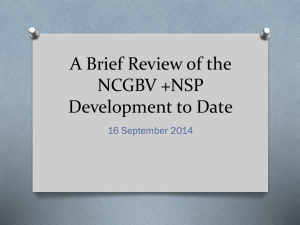daumar, cherry dale (module 2)final
advertisement

At this time, even how advance the generation is, when you visit classrooms, the most common instructional material you will find are those that are twodimensional. is consist of only length and width. They are paper based, opaque material that are commonly found in classrooms. • Boards • Graphic Materials • Picture and Photographs • Postcards • Flashcards • a vertical surface on which information can be displayed to public view Types of Boards 1. Chalk Boards 2. White Boards and Magnetic Boards 3. Cloth Boards(Felt, Fannel,and Carpet) 4.Hook-and Loop Boards (Velcro Boards) 5. Pegboards 6.Bulletin Boards • These are the most common instructional media found in classrooms, rural and urban alike. • Aside from using it as a medium for verbal communication, it is also used as surface where pictures, posters, graphs, charts and etc. • Chalk dust can • Generally suitable trigger asthma or for different age respiratory problem groups, class size, and subject matter. • Does not provide permanent records • It is not dependent • Some information to electricity. cannot presented • It is economical and well using a reusable chalkboard. • Also sometimes called multipurpose boards • These with glossy surface, commonly white in color, where non-permanent markings are made with the use of special felt pens. • White boards becomes a magnetic boards when it is made with metal base. • Become popular around the 90’s when there was a growing concerns on the potential health risks of chalk dust. • Using markers does not generate dust that comes from using the erasing chalk. • Whiteboards marker is easier to hold and write with compared to chalk and marking a whiteboards takes less time. • The white backgrounds can cause problems to those with vision impartment. • Left-handed person may find it difficult to write on these boards because left-handed individuals usually write with their hand curved around the pen therefore causing their hand to drag across the strokes previously made. • This is a piece of plywood or heavy cardboard covered with either felt, fannel or carpet. The fuzzy surface of a felt, fannel, or carpet allows visual material with appropriate backing adhere. • A plywood or heavy card board is covered with a nylon loop material and the nylon hooks are adhere on the back of the instructional materials to be displayed on the board. • Are made of tempered masonite with 1/8- inch holes drilled 1 inch apart. These boards are used in displaying three-dimensional objects or heavy materials with the use of hooks inserted into the boards. • Are generally not used directly in instruction but tend to be supplement. • These boards are usually designed as an instructional device that can carry message with out the presence of a teacher. • Uses: display notice, and announcements, classroom rules, and procedures, seasonal items, and student work. • Translate abstract ideas and relationships into a concrete form. They are non-photographic, two – dimensional materials designed to communicate a message to the viewer. • They often include verbal as well as visual symbols. • Convey certain types of information in a condensed form • Readily available • Can be easily carried from one place to place • Not interactive • Lack depth and motion • Can be easily misinterpreted 1. drawing and sketch 2. cartoons 3. strip drawing 4. posters 5. charts 6. graphs 7.diagrams 8.maps • Drawing and Sketches employ the use of lines, either simple or crude. They may not be the real thing but they may present persons, places, things, and concepts. are more finished and representational compared to sketches. usually lack details such as stick figures . • Cartoons use symbolism and oftentimes bold exaggeration to present at a glance a message or point concerning news event , people or situations. • It is a form of cartooning in which a cast of character enacts a story in a sequence of closely related drawings. • Scrip drawings is a more accurate term for the commonly called comics or comic strip. • Scrip drawings can be used for motivation or starter for a lesson. • Posters are combination of lines, images, colors and words. Intended to catch attention and communicate a message quickly. • Can be used to stimulate interest in a new topic, a special class, or a new event. • Charts are graphic representation of abstract relationships such as chronologies, quantities, and hierarchies. • • • • • • • Organization charts Classification charts Time lines Tabular charts or tables Flowcharts or process charts Tree or stream chart Gannt Chart • Shows an organization’s structure or chain of command. It illustrates the interrelationship between parts of an organization. • They are similar to organization charts but its purpose is to show the classification or categorization of objects or species. • Time lines show in sequence different events or the relationship of people and events. • They are very helpful in summarizing series of events. • Contain numerical information or data in a table or columns. • These kind of charts show a process, sequence, or procedure. • These kind of charts shows change, growth or development by beginning with a single course and then spreads out into many branches or by beginning w/ many branches w/c then come together into single channel. • Is an activity time chart that illustrate the start and finish dates of a certain activity or project. • Graphs show quantitative data. These kind of graphics make analysis and interpretation of numerical information easier. • • • • • Line graphs Bar graphs Pie graph Solid graphs pictographs • Are used when plotting trends of relationship between series data. • Shows the progress over a period of time. • The simplest and easiest to read. The data are presented in horizontal or vertical bars. • While the widths of the bar are the same, its length represents the amount or percentage data. • Always present whole amounts and its parts are calculated in percentage or fractional parts. • Used to compare several related totals thru the use of geometric shapers. • Graphs are utilize related pictures or drawing to show numerical data. It is an adaptation of bar graph. • Are intended to show relationship or to help explain a process, how something works or how something is constructed. • • • • • • Cloud diagram Chain of events Fishbone mapping Cycle Compare/ contrast Venn diagram • Used in a nonlinear activity wherein ideas, images, and feelings are generated around a stimulus word. • Diagram illustrates the stages of an event, the action of a character or the steps in a procedure. • Used to show causal interaction of a complex event or complex phenomenon. • Illustrates how series of events interact to produce a set of result such as the life cycle. • A diagram that is used to show similarities and differences. • Used to show relationship between sets, similarities and differences between character, stories or poem. • Maps are representations of earth’s surface or a part of it. • Political maps • Physical maps • Commercial or Economic Maps • Generic term picture includes any kind of opaque representation of visual images w/c includes drawings, photographs, pictures in books and magazines, or any medium open to the artist’s interpretation. • These are commercially printed with space on one side for an address and postage stamp used for sending a short message through mail. • These material are used for all drill activities in teaching certain topics. • Flash cards may contain words, phases, sentences, math combination or pictures. • • • • • http://www.google.com.ph/imglanding?q=Classification+Charts&hl=en&gbv=2&tbm=isch&tbnid=KjWVH25jSYyZx M:&imgrefurl=http://rohlenscience.pbworks.com/w/page/7859192/InsectsNotes&imgurl=http://rohlenscience.pbworks.com/f/1251375466/ClassificationChart.gif&w=309&h=400&ei=w5q yTb3rE424vgPHm8mJBw&zoom=1&iact=hc&page=1&tbnh=121&tbnw=93&start=0&ndsp=18&ved=1t:429,r:0,s:0 &biw=1124&bih=509 http://www.google.com.ph/imglanding?q=Timelines&hl=en&sa=X&gbv=2&tbm=isch&tbnid=hZKzFZPm1D5wXM: &imgrefurl=http://www.ncs-tech.org/%253Fp%253D1075&imgurl=http://www.ncs-tech.org/wpcontent/uploads/2008/01/circavie.jpg&w=450&h=301&ei=iZuyTejgAoX2vwP2p8jBg&zoom=1&iact=rc&page=1&tbnh=117&tbnw=173&start=0&ndsp=14&ved=1t:429,r:4,s:0&biw=1124&bih=509 http://www.google.com.ph/imglanding?q=Tabular+Charts+or+Tables&hl=en&gbv=2&tbm=isch&tbnid=7Xp73za1_GsjM:&imgrefurl=http://sonic.net/mnitepub/pccafe/reviews/macromedia_dreamweaver3/index.html&imgur l=http://sonic.net/mnitepub/pccafe/reviews/macromedia_dreamweaver3/tabular_table.gif&w=500&h=271&ei= CpyyTd28FIWWvAPvo42HBw&zoom=1&iact=rc&page=1&tbnh=82&tbnw=151&start=0&ndsp=18&ved=1t:429,r:3 ,s:0&biw=1124&bih=509http://www.google.com.ph/imglanding?q=Flow+Charts+for+Process+Charts&hl=en&sa= X&gbv=2&tbm=isch&tbnid=hJujSqODNXuwKM:&imgrefurl=http://www.presentationmagazine.com/create-yourown-flow-chart-or-process-flow-slides-551.htm&imgurl=http://www.presentationmagazine.com/powerpointtemplates/00422/468slide2.jpg&w=468&h=351&ei=t5yyTdPMDovovQOS1PiGBw&zoom=1&iact=hc&page=1&tbn h=121&tbnw=181&start=0&ndsp=21&ved=1t:429,r:4,s:0&biw=1124&bih=509 http://www.google.com.ph/imglanding?q=Tree+or+stream+charts&hl=en&gbv=2&tbm=isch&tbnid=cVw8L5lwEX DEcM:&imgrefurl=http://www.familydetails.com/community/Articles/articleType/ArticleView/articleId/2074/AFamily-Tree-Diagram-Keeping-The-Genes.aspx&imgurl=http://www.familydetails.com/images/articles/familytree-chart3f41.png&w=397&h=500&ei=J52yTZbXBYTyvQP08pmVBw&zoom=1&iact=hc&page=1&tbnh=119&tbnw=94&star t=0&ndsp=19&ved=1t:429,r:2,s:0&biw=1124&bih=509 • • • • • • http://www.thefreedictionary.com/board http://www.google.com.ph/imglanding?q=powerpoint+backgrounds+school&um=1&hl=en&tbm=isch&tbnid=G-R_af39gk5bM:&imgrefurl=http://www.freeppttemplates.net/default.asp%253Fpind http://www.google.com.ph/imglanding?q=animated+chalkboard&um=1&hl=en&tbm=isch&tbnid=s0uYvZdgvZU AAM:&imgrefurl=http://www.zingerbug.com/graphic.php%253FMyFile%253Dback_2_skool_chalkboard.php%2 526ID%253DC381.php&imgurl=http://www.zingerbug.com/holidays/glitter_graphics/back_2_skool_chalkboard .gif&w=325&h=239&ei=sI2yTY7hGIicvgPHuJSLBw&zoom=1&iact=rc&page=1&tbnh=159&tbnw=230&start=0&n dsp=8&ved=1t:429,r:6,s:0&biw=11 http://www.google.com.ph/imglanding?q=comic+strip&hl=en&gbv=2&tbm=isch&tbnid=PS6Rd6Um9pz4M:&imgrefurl=http://forums.techguy.org/thread-games-arcade-discussion/574930-google-picture-game237.html&imgurl=http://forums.techguy.org/attachments/173023d1276526533/comicstrip.gif&w=725&h=519&ei=OpiyTffNEoiSuAPKJyXBw&zoom=1&iact=rc&page=1&tbnh=117&tbnw=163&start=0&ndsp=18&ved=1t:429,r:2,s:0&biw=1124&bih =474 http://www.google.com.ph/imglanding?q=poster&hl=en&gbv=2&tbm=isch&tbnid=_xxoWedk7ducM:&imgrefurl=http://www.un.org/events/peaceday/2007/commemoration_burundi.shtml&imgurl=http://ww w.un.org/events/peaceday/2007/images/idp-poster07.gif&w=640&h=960&ei=N5myTd6vGY26vQPa5dGiBw&zoom=1&iact=rc&page=2&tbnh=167&tbnw=111&star t=14&ndsp=14&ved=1t:429,r:9,s:14&biw=1124&bih=474 http://www.google.com.ph/imglanding?q=Organizational+Charts&hl=en&gbv=2&tbm=isch&tbnid=cEFSLaPJ8TJ xlM:&imgrefurl=http://extension.missouri.edu/main/about/orgcharts/index.aspx&imgurl=http://extension.mis souri.edu/main/about/orgcharts/EXT-ORG-CHARTJune06.jpg&w=563&h=439&ei=lZqyTcPNKYuevQPSrLmKBw&zoom=1&iact=rc&page=4&tbnh=166&tbnw=213& start=27&ndsp=9&ved=1t:429,r:6,s:27&biw=1124&bih=509 • • • • • http://www.google.com.ph/imglanding?q=area+graphs&hl=en&gbv=2&tbm=isch&tbnid=YFdREMLJk_hhdM: &imgrefurl=http://infosthetics.com/archives/2009/01/nba_basketball_team_heat_maps.html&imgurl=http:/ /infosthetics.com/archives/nba_graphs2.jpg&w=600&h=569&ei=1ZyTbDFOYymvgOuq_WFBw&zoom=1&iact=rc&page=3&tbnh=168&tbnw=177&start=26&ndsp=8&ved=1t:429, r:6,s:26&biw=1124&bih=509 http://www.google.com.ph/imglanding?q=Pictorial+graphs&hl=en&gbv=2&tbm=isch&tbnid=dyBm336gLJJCz M:&imgrefurl=http://www.tutorvista.com/math/tally-marks-graphproblems&imgurl=http://image.wistatutor.com/content/feed/u352/tally%252520graph.PNG&w=301&h=397 &ei=lqCyTayMOIuMvQOpnpGjBw&zoom=1&iact=hc&page=7&tbnh=167&tbnw=127&start=51&ndsp=10&ve d=1t:429,r:7,s:51&biw=1124&bih=509 http://www.google.com.ph/imglanding?q=Cloud+diagrams&hl=en&gbv=2&tbm=isch&tbnid=tLtd4D1sQdkIM:&imgrefurl=http://www.mkbergman.com/457/a-new-constellation-in-the-linking-open-data-lodsky/&imgurl=http://www.mkbergman.com/wp-content/themes/ai3/images/2008Posts/080922_loddatasets.png&w=720&h=557&ei=GqGyTZ2NBoe6vQPirLCPBw&zoom=1&iact=rc&page=1&tbnh=121&tbnw=1 58&start=0&ndsp=18&ved=1t:429,r:5,s:0&biw=1124&bih=509 http://www.google.com.ph/imglanding?q=Chain+of+events&hl=en&sa=G&gbv=2&tbm=isch&tbnid=0aW6WZ 6AB9XzqM:&imgrefurl=http://www.gutsense.org/gutsense/autism.html&imgurl=http://www.gutsense.org/g utsense/img/Autism_Flowchart.jpg&w=491&h=759&ei=vqGyTcvHAYy6vQO8rpmZBw&zoom=1&iact=rc&page =2&tbnh=166&tbnw=107&start=20&ndsp=9&ved=1t:429,r:0,s:20&biw=1124&bih=509 http://www.google.com.ph/imglanding?q=Fishbone+mapping&hl=en&gbv=2&tbm=isch&tbnid=bsY7chp248K tAM:&imgrefurl=http://www.mindmapper.com/pro/pro2_2.asp%253FMENU%253Dm1&imgurl=http://www. mindmapper.com/images/v50/mm50_34.jpg&w=432&h=276&ei=O6KyTfywMYm8uwPWs_DBg&zoom=1&iact=rc&page=1&tbnh=125&tbnw=196&start=0&ndsp=12&ved=1t:429,r:3,s:0&biw=1124&bih= 509 • • • • • http://www.google.com.ph/imglanding?q=Cycle&hl=en&gbv=2&tbm=isch&tbnid=IxINpHzrWCcLeM:&imgrefurl =http://www.solcomhouse.com/hydrologiccycle.htm&imgurl=http://www.solcomhouse.com/images/hydrowea th.jpg&w=575&h=584&ei=LKOyTfPEpC4vQPzs9CJBw&zoom=1&iact=rc&page=5&tbnh=169&tbnw=156&start=37&ndsp=9&ved=1t:429,r:4,s:37& biw=1124&bih=509 http://www.google.com.ph/imglanding?q=Compare/+Contrast&hl=en&gbv=2&tbm=isch&tbnid=iC4a6um2lLruy M:&imgrefurl=http://www.grossmont.edu/lucinda.sawyer/week12.htm&imgurl=http://www.grossmont.edu/lu cinda.sawyer/images/matrix2.gif&w=438&h=295&ei=maOyTYH9LYfcvwPi1bmGBw&zoom=1&iact=rc&page=3& tbnh=161&tbnw=239&start=28&ndsp=8&ved=1t:429,r:6,s:28&biw=1124&bih=509 http://www.google.com.ph/imglanding?q=Venn+diagram&hl=en&gbv=2&tbm=isch&tbnid=QsPLkfWB842OXM: &imgrefurl=http://berniesumption.com/photography/beginners-guide-forgeeks/&imgurl=http://berniesumption.com/photography/files/2010/10/venndiagram.gif&w=225&h=225&ei=E6SyTZKaMYjyvwOD0qyNBw&zoom=1&iact=rc&page=8&tbnh=166&tbnw=166 &start=66&ndsp=8&ved=1t:429,r:0,s:66&biw=1124&bih=474 http://www.google.com.ph/imglanding?q=Pictures+and+Photographs&hl=en&gbv=2&tbm=isch&tbnid=fzoaVf3 aaNjxbM:&imgrefurl=http://www.sauria.com/blog/tag/photographs/&imgurl=http://farm1.static.flickr.com/16 6/337186911_610dabe6cc.jpg&w=500&h=333&ei=s6SyTZaAB5GSuwOQvvmTBw&zoom=1&iact=rc&page=1&tb nh=111&tbnw=142&start=0&ndsp=19&ved=1t:429,r:10,s:0&biw=1124&bih=509 http://www.google.com.ph/imglanding?q=Postcards&hl=en&gbv=2&tbm=isch&tbnid=AEDJhsbPCXYWM:&imgrefurl=http://www.limavadyhigh.co.uk/2009/11/&imgurl=http://www.limavadyhigh.co.uk/ wpcontent/uploads/2009/11/postcards.jpg&w=499&h=357&ei=jKWyTf3UKYSGvAO89c2LBw&zoom=1&iact=hc&p age=2&tbnh=169&tbnw=214&start=9&ndsp=10&ved=1t:429,r:8,s:9&biw=1124&bih=509 • • • • http://www.google.com.ph/imglanding?q=Gantt+Chart&hl=en&sa=G&gbv=2&tbm=isch&tbnid=FNHWGOwNnx Ow1M:&imgrefurl=http://wordsmithbob.com/blog/403/your-most-important-client-orcustomer/&imgurl=http://wordsmithbob.com/blog/wp-content/uploads/2008/11/gantt-chart-your-mostimportant-client-or-customer-is-you.gif&w=591&h=344&ei=tZ2yTZqVDoS6vwOf42bBw&zoom=1&iact=hc&page=1&tbnh=128&tbnw=220&start=0&ndsp=8&ved=1t:429,r:5,s:0&biw=1124&bih= 509] http://www.google.com.ph/imglanding?q=Line+graphs&hl=en&sa=G&gbv=2&tbm=isch&tbnid=J4a3kTG9LxOPu M:&imgrefurl=http://www.lisisoft.com/tools/linegraph.html&imgurl=http://www.lisisoft.com/imglisi/7/HelpfileTools/31450linegraph.gif&w=325&h=325&ei=Wp6yTeLJAoTsuAObhWKBw&zoom=1&iact=hc&page=1&tbnh=115&tbnw=115&start=0&ndsp=12&ved=1t:429,r:0,s:0&biw=1124&bih =509 http://www.google.com.ph/imglanding?q=Bar+graphs&hl=en&sa=G&gbv=2&tbm=isch&tbnid=cY-BvEi3R236M:&imgrefurl=http://www.slidewrite.com/Samples.asp&imgurl=http://www.slidewrite.com/images/1x2_3dbar .gif&w=420&h=328&ei=0Z6yTb_DoLqvQOoy62aBw&zoom=1&iact=hc&page=10&tbnh=173&tbnw=222&start=82&ndsp=8&ved=1t:429,r:5,s:82& biw=1124&bih=509 http://www.google.com.ph/imglanding?q=Pie+graphs&hl=en&sa=G&gbv=2&tbm=isch&tbnid=9kASUUlfUXOwM:&imgrefurl=http://www.designfreebies.org/design-tutorials/vector-tutorials/vector-tutorialcreating-a-killer-3d-pie-chart-in-illustrator/&imgurl=http://www.designfreebies.org/wpcontent/uploads/2009/04/gdfr-illustrator-pie-chart-finall.jpg&w=450&h=329&ei=OZ-yTafODY2vQP1hN2YBw&zoom=1&iact=hc&page=1&tbnh=162&tbnw=222&start=0&ndsp=9&ved=1t:429,r:6,s:0&biw=11 24&bih=509








